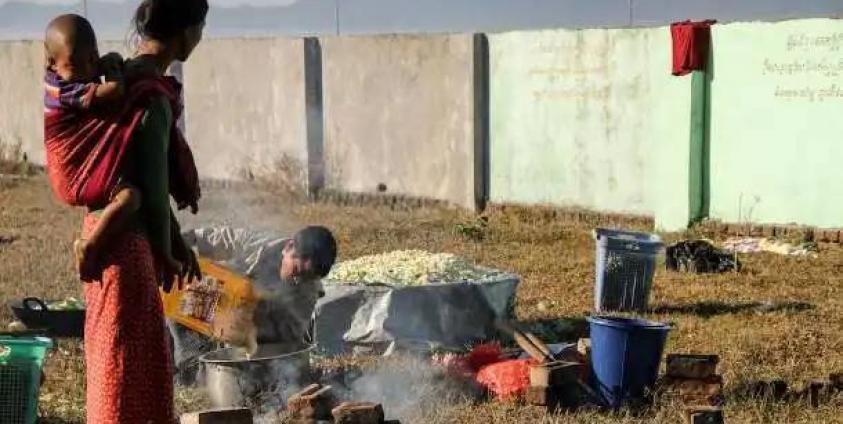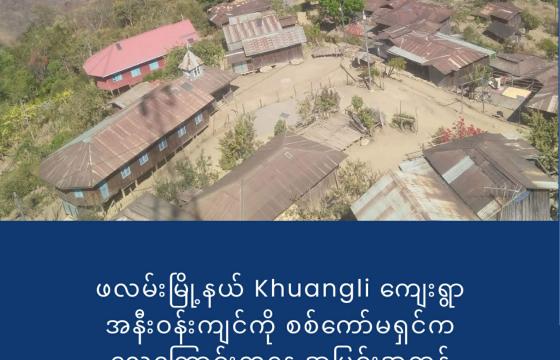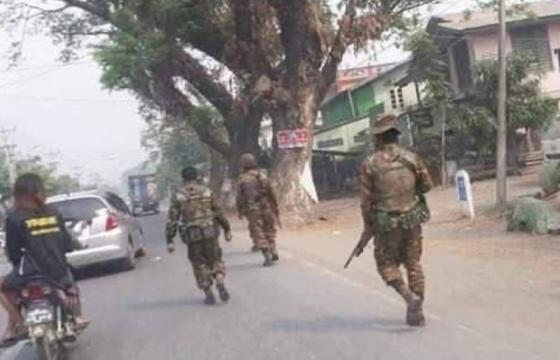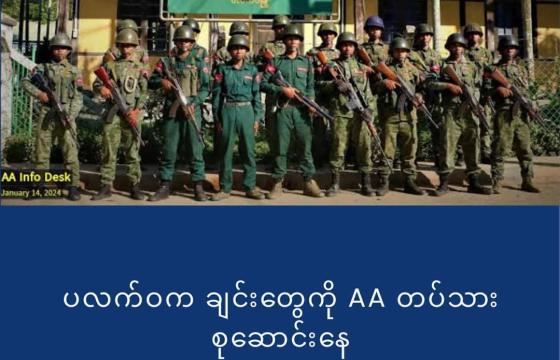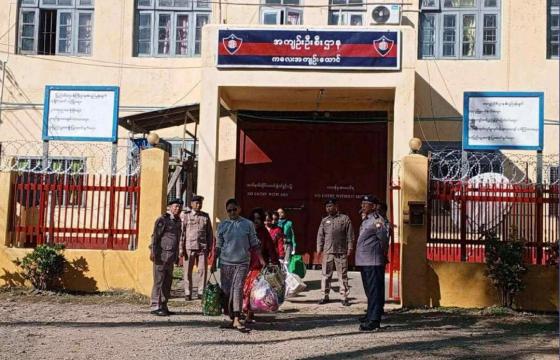Salai Hung Tun Gei — While Myanmar is going through a phase of high commodities, Chin State on the other hand in the northwest of the country is starting to face a shortage in goods.
Chin State is a state in the whole country that doesn’t produce any kind of products including natural resources.
Whereas other regions and states are producing timber, gems, natural gas, and other resources which are exported domestically and abroad.
Even when some aren’t producing natural resources, they are producing rice, fruits, and vegetables which can be relied on locally or even be distributed to other regions.
Chin State covers an area of 36,019 square kilometers and is located west of Sagaing, Magway Regions, and Rakhine State. Moreover, it is adjacent to India. To this day, there has been no local product of Chin State in the market and it has been relying on products of other regions.
According to Myanmar’s 2014 census, Chin State has a population of over 470,000. It has been considered the poorest state in Myanmar by previous governments and in education, it doesn’t have any university with the lowest matriculation pass rate annually, and also a state that doesn’t have an airport. After 2010, only three universities were opened but now the progress of those universities has been stopped.
The construction of Surbung Airport in Falam began and was in the finishing state during the NLD government but it was stopped after the coup and the airport is not in an operational condition.
Moreover, according to the records of UNICEF, Chin State has the second most percentage of disability in the whole country. The biggest percentage of disability in Myanmar is Ayeyarwaddy Region and it is said to be the consequence of the 2008 Nargis storm. As for the high rate of disability in Chin State, UNICEF stated that it is because of malnutrition.
For commodities and goods, northern Chin State relies on Sagaing, and southern Chin State, relies mainly on Magway and Rakhine. Import goods are being transported from Mandalay only on land through Sagaing and Magway.
Due to its borders with India, there was the establishment of border trade points after the 2010 political transition but the projects didn’t reach any trading conditions.
The Kaladan Port project funded by India at the only waterway in southern Chin State in Palatwa hasn’t also been finished. It was planned to be finished during the NLD government but after 2016, there were fierce battles between the Arakan Army and Burmese military in Palatwa, destruction of goods while on trade, and workers were captured and the project was slowed down. To this day, it cannot be used.
Currently, there are battles between the military council and local Chin defense forces at the Rihkhordar border gate in Falam, northern Chin. More than 2000 locals fled to India and now the gate has been closed. That particular gate is connected to a landlocked state called Mizoram State in India and the border gate is a source of foreign currency as Myanmar’s commodity, beetle nuts, and other goods from Sagaing Region are being transported to India through Chin State. Although, it does not receive import goods from India.
The Kalay-Phalan-Tedim route which 5 northern Chin State townships are relying on for the transport of basic commodities and rice has been closed because of the battles between Chin Defense Forces and the military council during the whole month of January and as the fights grew intense, it has to remain close with the reason of the spreading Omicron virus. Battles continue on that particular land route every month. It has been months that the travel fee is four times higher than normal when the route is not closed. The travel fee was previously between 10,000 to 15,000 kyats but now it is 70,000 to 100,000 kyats. The transport fee for goods is now five times higher too.
The battles are also intense on another land route to northern Chin State, Kalay-Waybula-Falam route. There was airstrike assistance by the military council that whole villages had to flee. Not only the battles are fierce on that route but also military troops are positioned there and passenger vehicles and cargo trucks are not allowed anymore. That’s how and why the commodity prices got high since the beginning of the spreading of Covid and are currently at their worst after the coup in northern Chin State. And now, besides the rise in prices, there are shortages.
There are battles between the military council and Chin defense forces on Magway and Chin border which Mindat, Matupi, and Kanpetlet are relying on for basic commodities and goods, battles among Yaw People’s Defense Forces, and battles between Mindat and Matupi. And for those reasons, it has been quite a long while since there have been shortages. Previously the fee for passenger vehicles between Matupi and Sagaing Region’s Pakokku was around 17,000 and 20,000 kyats but now when the route is open and travel is allowed, the fee is possibly between 150,000 to 300,000 kyats. Moreover, the travel could last more than a week as a result of the ongoing battles. In previous months, there was no rice to purchase in Matupi some households had to only eat porridge and cook broken rice.
Elephant food yam thrive in southern Chin State and later on, they were grown as the export rate to Japan and China rose. During U Thein Sein government and NLD government, there were activities about building factories for drying elephant food yam and contracts with Japan to export 500,000 tons of the product annually. But now, everything is ceased. Elephant food yam farmers are now IDPs and some are frightened to go to the fields and elephant plant farms had to be deserted. Since there is no market for it anymore, the plants that were already dug are abandoned in piles.
Since Chin State has always been depending on the mainland for rice, goods, construction materials, garments and commodities, the prices were originally high. Although the Chin people mainly work in agriculture with some having private businesses, most of them are mainly dependent on family members and relatives living abroad.
In the 1990s, after the 1988 uprising, there were a lot of Myanmar migrant workers in Malaysia, Thailand, and India. From those countries, people applied themselves as refugees to the UN, moved to third countries, and stay there as a citizen. The development in basic infrastructure is partly the consequence of the support of those relatives abroad. Although the rise in prices, because of the support of relatives and family members abroad, there wasn’t much problem for the locals. But since the banks in Chin State were being closed up, transferring money has become an issue. The money from abroad, first has to be received in Yangon, Mandalay, or other townships and then transfer to Chin State. When doing the transfer, since physical cash has become scarce, a transfer fee of 7% to 10% was cut.
The rise of oil prices in the wake of Ukraine and Russia has also hit Myanmar, with prices of gas and diesel skyrocketing. The prices of gas and diesel have been shooting up since the coup and in the last four or five months, some townships in Chin State didn’t even have any more to buy and sell. Vehicles are being left on the road there was no more fuel while driving.
Now that the prices of fuel have skyrocketed in the mainland, and for Chin State where transportation is already difficult with land transport the only available way, and which has been facing shortages of commodities for months since the coup, it is now going through the worst of disasters. It is starting to face issues such as not being able to buy anything even if one has money, vehicles not being to transport goods because of the ongoing battles, and transport costs being ridiculously high even when transportation is available.
Besides transportation being difficult in Chin State, there are the destruction of roads and erosion every year in the rainy season and for those reasons, people need to start gathering rations in summer. But since the battles between people’s defense forces and the military council have been worsening, and battles occurring on the roads between towns, people are likely to suffer the notorious four cuts strategy by the military council.
After the worst natural disaster in 2015 landslide in Chin State, it faced a situation where transportation was cut, commodity prices were too high and shortage of rice. The government sent rations of rice on helicopters on days when the weather was good. Back then, observing the weather, religious organizations and civil society organizations came together, making plans to be able to travel to the mainland for about a week by using big machines with the purpose of purchasing rice, then they would resell the rice to the locals with normal prices, take control of the prices of rice, and sending rice to villages on foot.
But currently, the situation is very different from 2015, as those religious organizations are fleeing and civil society organization leaders leading the battles in local defense forces with young people taking up arms to resist the dictatorship.


